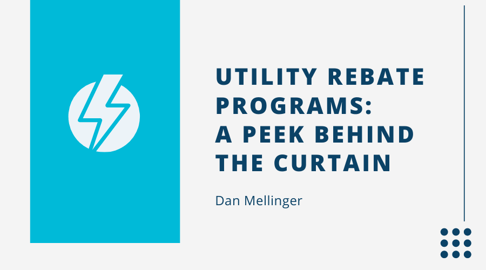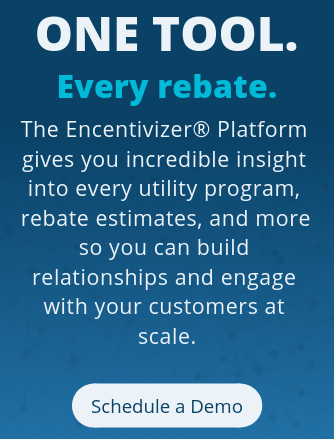
Utility programs that offer rebates for the purchase and installation of energy efficient equipment are now commonplace in most markets across North America. The concept has been around for decades, and in recent years the presence of these programs has expanded to nearly all areas and the range of products and technologies has increased. For customers and supply chain actors in many markets, rebates are a driving force in purchasing decisions. But where exactly does the rebate money come from, and why would an electric or gas utility want to encourage their customers to use less of the very product that they sell?
In this article we’ll peek behind the curtain of utility rebate programs and explore these questions and more.
Where does the money come from?
When a utility distributes a rebate for the purchase and installation of energy efficient equipment, they are not paying that rebate out of their own pocket. Rather, rebate programs are funded by the same customers that they benefit! In most cases, all ratepayers pay a relatively small surcharge on their monthly utility bill, and these collected monies are used to fund equipment rebates and the programs that deliver them (including staff, marketing, education, etc.). The policies that dictate the amount of the surcharge, and the total program budget, are established by a state legislature and/or a regulatory body such as public utility commission. These policies can vary dramatically from one state to the next, which is a big factor in why the same type of equipment might be eligible for a high rebate from a utility in one state, and a much lower rebate from a utility in another state. Through a series of regulatory plans and processes, a utility will establish annual or multi-year budgets and savings goals. Often, these plans include separate targets across residential, commercial, industrial customer sectors. Utility programs must strictly adhere to these plans, goals, and budgets to avoid financial penalties.
Why would an electric utility want to sell less electricity?
The concept of a utility encouraging its customers to use less energy can seem counterintuitive at first. The idea starts to make sense if you think about customers not only as consumers of energy, but also as a potential energy resource if they are able to use less energy than they would otherwise. By encouraging a customer to adopt energy efficient equipment or practices, the energy that would have been required to meet the baseline need can be sold elsewhere, offsetting additional energy purchases. A rebate program makes economic sense if the energy savings can be acquired at a cost lower than what would be required for the utility to purchase the energy elsewhere. For example, an electric rebate program may be able to achieve energy savings at a cost of 3 cents per kilowatt-hour (kWh) compared to 4 cents per kWh the utility would pay to purchase wholesale electricity. An energy efficiency program is an important tool that can help a utility meet its current and future customer demand in the most cost-effective manner possible. And while a utility will sell less energy as a result of an energy efficiency program, their revenue is typically based on fixed assets and not sales. A variety of financial mechanisms can also be used to ensure that an energy efficiency program is a financial benefit to a utility and its investors.
How does a utility determine which products are eligible for rebates?
A utility’s annual or multi-year plan will include a diverse set of programs, technologies, and products that aim to serve all customer sectors equitably. Utility programs typically have specific goals and objectives to serve low income residential and small business customers. Sometimes rebate offers are tailored to address issues that a utility faces, such as transmission constraints in certain parts of a service territory or the coincidence of the energy savings with seasonal system peaks. And the portfolio of products will include a variety of technologies intended to meet the needs of different projects and customer types. Importantly, all product rebate offers must be deemed cost effective according to the state or regulatory screening criteria. These cost effectiveness tests consider whether the benefits of an investment in energy efficiency outweigh the costs. Depending on the state, the method for evaluating cost effectiveness may consider benefits and costs for the utility, the participant, or both. Finally, utilities want to ensure that the equipment they support will realize the promised savings and will remain installed for the estimated useful life. For this reason, product rebates often carry requirements around product specifications, product qualification (such as ENERGY STAR® and DLC®), installation, and commissioning.
How do utilities track the energy savings?
You might think that measuring the energy savings from newly installed equipment would be easy, after all the utility has a meter for every customer. Rarely, however, is a customer’s meter data used to verify project savings. There are simply too many variables that can influence overall electricity usage, such as the weather, operating schedules, unpredictable use of other equipment, the economy, and now we must include pandemics in the list of factors. Instead, utilities use a variety of methods to estimate, calculate, or measure the energy savings from a project. When rebates are paid through point-of-purchase (retail, or wholesale “midstream”) and mail-in rebate forms (“prescriptive”), the savings are calculated based on a mix of known and estimated values. The type of equipment and quantity installed will be known and information about the operating schedule are sometimes reported. Engineering estimates are then used for factors such as the baseline equipment type, incremental cost (the cost difference between the baseline and energy efficient equipment), equipment lifetime, and other factors. The goal of this exercise is to calculate project savings that are reflective of the average condition, which could be very different from what any one customer experiences. For rebates received through custom programs, the energy savings calculation includes inputs that are specific and unique to the project. This approach is often reserved for larger projects and/or unique equipment for which the utility does not offer rebates elsewhere. The resulting calculation will reflect a close estimate of what the customer will realize, and the rebate will be tailored to the project economics. For certain custom projects, the utility may install sub-meters to precisely measure the performance of the equipment. Finally, performance programs will include some form of energy measurement occurring before and after the project, and the value of the rebate will be dependent on the level of savings achieved. Importantly, the energy savings reported through all these methods may be subject to evaluation review at some point. The responsibility falls on the utility to track and record savings as accurately as possible, and failure to do so caries financial risk.
Does it have to be so complicated?
As with all things related to an energy utility, the planning and administration of rebate programs are complex undertakings. To an outside observer, the volume of forms, participation requirements, quantity limits, qualification standards, and post-installation verification can seem excessively burdensome. The utility is striving to strike a balance between ease of participation and risk management. If participation is too low, or if the claimed savings don’t stand up to evaluation, a program may fail to reach its goals and performance incentives will be missed. If participation is too high, a program may exhaust its budget and need to shut down mid-year, causing severe and sometimes irreparable disruption to the market. The utility programs that are best positioned to navigate this challenging mandate will offer a diverse portfolio of programs and technologies, multiple pathways to deliver rebates, and comprehensive strategies to engage with customers and supply chain actors.
.png?width=500&name=2019%20e%20news%20spotlight%20logo%20(1).png)




